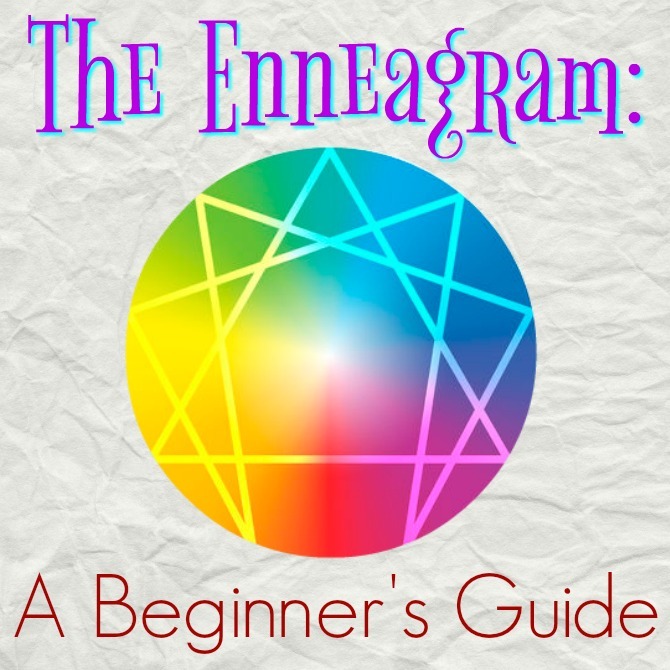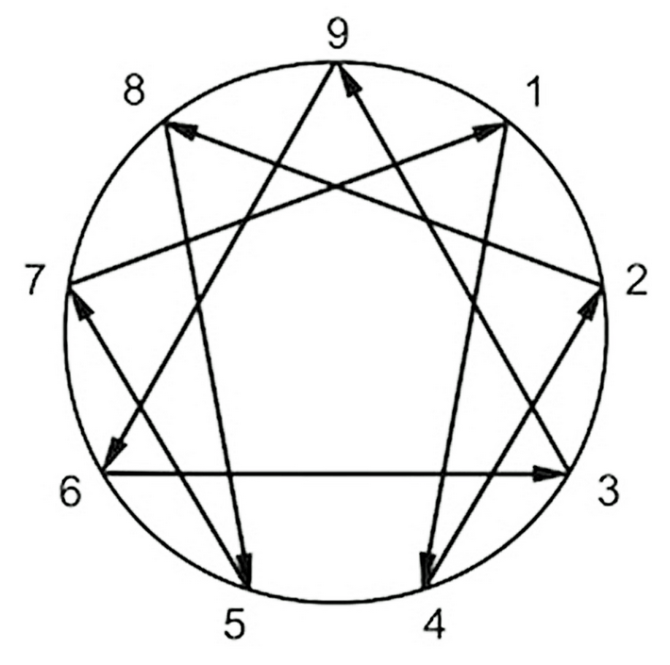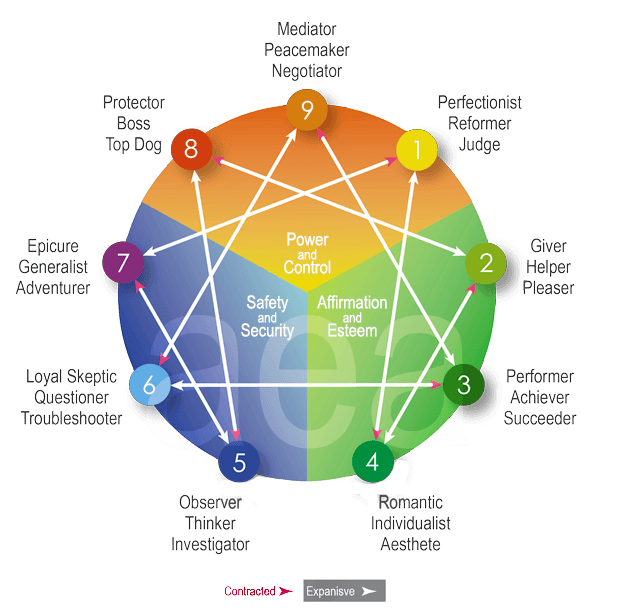Last week we kicked off our personality series with an introduction to the Myers-Briggs personality model. I loved all of the great feedback I received and was excited to see how many of you are personality junkies, too! This week we are diving into a personality system that’s not quite as well known, but that’s been gaining more attention in recent years: The Enneagram.

A Little Background
Though I’m personally pretty new to the Enneagram (pronounced any-a-gram), it’s actually been around for quite a while. The origins of the model are disputed, with many experts believing that elements of the Enneagram can be traced back thousands of years to the sacred geometry of the Pythagoreans. Variations of the model appear in Islamic Sufi traditions, and aspects of the Enneagram were adopted and preserved by early Christian mystics. More recently George Gurdjieff, a contemporary of Freud, used the Enneagram to explain the laws involved in the creation and unfolding of the universe.
The Enneagram model as we know it today was developed by a Bolivian named Oscar Ichazo who began teaching the Enneagram in the 1950s. Claudio Naranjo, an American psychiatrist born in Chile, initially studied the Enneagram with Ichazo and brought it to the United States in the 1970s.
Like the Myers-Briggs model, the Enneagram is useful for helping us become more self aware and uncover unconscious patterns in our behavior. It is also effective in helping us develop tolerance and compassion for others as we gain an understanding of their motivations and behaviors. The Enneagram is unique from other personality models in that it offers a distinct path for personal growth and emotional healing.
The Basic Structure
The name Enneagram comes from the Greek words ennea (nine) and gramma (point), and the Enneagram figure is made up of nine points representing distinctive personality types. Each of these types is driven by a core value that guides behavior. While we might resonate with aspects of each of the types, everyone emerges from childhood with one of the nine types dominating their personality. The types go by various nicknames but are usually referred to by their numbers.
These numbers are simply names and are value neutral: bigger numbers are not better or worse than smaller ones, and no type is inherently better or worse than any other. Each type has its own assets and liabilities, and you can fluctuate between the healthy and unhealthy traits that make up your type. However, people do not change from one basic personality type to another (though many experts believe it takes people a while to age into their type, and that you shouldn’t begin exploring the Enneagram until your late 20s or even your 30s).

The Nine Types
Below are descriptions of the nine types. (I’m including a very brief overview of the types, but I’ve also linked each title to a thorough type description where you can read more.) Reading through these, you will likely find yourself resonating strongly with one of the types. It’s not uncommon for the type that appeals to you the least to be your type, as we tend to strongly dislike the flaws we see in ourselves.
With each type I’ve included one or two of the most common names associated with the number. Keep in mind that each Enneagram expert seems to give the numbers a different set of names, so you might be familiar with different titles.
Type One (The Reformer or The Perfectionist)
Ones seek a perfect world and work to improve themselves and those around them. Ones have very high standards and place an emphasis on integrity and self-control.
Core Value: Goodness/Integrity
Strengths of Ones: principled, purposeful, improvement-oriented, honest
Weaknesses of Ones: non-adaptable, overly critical, resentful, impatient
Type Two (The Helper or The Giver)
Twos focus on relationship and excel at establishing connections and meeting the needs of others. They want to be accepted and liked by those around them and will adapt to achieve their approval.
Core Value: To feel needed or loved.
Strengths of Twos: empathetic, supportive, warm, generous
Weaknesses of Twos: naive, dependent, manipulative, possessive
Type Three (The Achiever or The Performer)
Threes organize their lives to achieve specific goals and receive recognition. Threes are very focused on image and are great at feeling out what is expected of them and adapting to meet those expectations in order to achieve success.
Core Value: Admiration
Strengths of Threes: successful, high-achiever, energetic, confident
Weaknesses of Threes: competitive, impatient, deceitful, overworked
Type Four (The Individualist or The Romantic)
Fours desire a deep connection with their own inner world and seek meaning and authenticity in their relationships and personal creativity. Fours often experience a sense of longing and melancholy, which can lead to feelings of envy.
Core Value: Authenticity
Strengths of Fours: creative, expressive, emotional depth, introspective
Weaknesses of Fours: temperamental, self-absorbed, withdrawn, uncooperative
Type Five (The Investigator or The Observer)
Fives focus on intellectual understanding and accumulating knowledge. They value privacy and personal autonomy, using emotional detachment as a way to minimize interaction with others.
Core Value: Understanding/Mastery
Strengths of Fives: analytical, objective, perceptive, self-reliant
Weaknesses of Fives: secretive, isolated, overly intellectual, stingy
Type Six (The Loyal Skeptic or The Questioner)
Sixes are insightful and prone to worry. They are good at anticipating problems and focus on developing solutions and maintaining the safety of themselves and others.
Core Value: Security
Strengths of Sixes: responsible, loyal, collaborative, strategic thinkers
Weaknesses of Sixes: suspicious, pessimistic, anxious, doubtful
Type Seven (The Enthusiast or The Epicure)
Sevens crave excitement and stimulation from new experiences and ideas. They prioritize fun and bring a sense of optimism and positivity to their activities.
Core Value: Satisfaction/Contentment
Strengths of Sevens: confident, adventurous, fun-loving, quick-thinking
Weaknesses of Sevens: impulsive, rebellious, scattered, self-absorbed
Type Eight (The Challenger or The Protector)
Eights are leaders who make things happen and like to have control over a situation. Eights prioritize fairness and justice, and their intensity can come across as intimidating to others.
Core Value: Power
Strengths of Eights: confident, decisive, strategic, action-oriented
Weaknesses of Eights: domineering, controlling, demanding, excessive
Type Nine (The Peacemaker or The Mediator)
Nines seek harmony in their relationships and their environment and dislike conflict, tension, and ill-will. In their desire to maintain balance, they frequently struggle with inertia and have trouble establishing priorities.
Core Value: Peace
Strengths of Nines: balanced, harmonious, diplomatic, affable
Weaknesses of Nines: procrastinating, unassertive, indecisive, conflict avoidant

Going Deeper
The Enneagram can get pretty complex. Since this is just a beginner’s guide, I won’t spend too much time delving into the deeper concepts and applications. However, when I was first learning about the Enneagram, all the “extra terminology” tripped me up, so below I’m including a brief overview of some of the other concepts related to the model to help you get your bearings if you decide to do more exploring.
The Centers of Intelligence: The nine types are divided into three subgroups that are each guided by a particular center—the gut, the head, or the heart. We all have all three centers, but each of the nine types is dominated by one of these three.
- The Instinctual (Gut) Center: Types 8, 9, and 1 –> Lead with the body; focus on being in control of themselves and their environment.
- The Emotional (Heart) Center: Types 2, 3, and 4 –> Lead with emotions; focus on relationships, affirmation, and success.
- The Intellectual (Mind) Center: Types 5, 6, and 7 –> Lead with ideas and rational thinking; focus on creating certainty and safety.
Wings: The two types adjacent to your Enneagram number are your wings. Most Enneagram theorists believe that we are not one specific type, but a unique mixture of our primary type and one of our wings. For example, an Enneagram 1 could have either a 9 wing or a 2 wing. While your basic type dominates your personality, your wing complements and adds to your overall personality and behavior.
Arrows: The lines within the Enneagram figure add further information about each type, representing how each number responds under different conditions. When relaxed or moving towards growth, you take on the positive quality of the number connected to yours in this order: 1-7-5-8-2-4-1 and 3-6-9-3. The reverse also applies: following the arrows backwards shows how each type behaves when under increased pressure or stress.
Figuring Out Your Type
There are a few online tests you can take to help you determine your Enneagram type: this test from Similar Minds is a good place to start. You can also try this test from Eclectic Energies, though my friends and I have had inconclusive results. The Enneagram Institute a more thorough test for $12 (I have not taken personally this test).
While a test might point you in the right direction in determining your Enneagram number, they are notoriously inaccurate. The best way to be sure of your type is to spend time reading over various descriptions of the type profiles to find which resonates most with you. I’ve taken several tests with vastly different results; it was only after studying the Enneagram on my own that I realized I was a Type One.
If you need more help, you can hire an Enneagram coach to work with you. A quick Google search will help you find one in your area.
Learn More
The Enneagram Institute offers a lot of great resources, including detailed type descriptions, workshops, and a newsletter. I also really enjoy The Road Back to You podcast, which explores the Enneagram through interviews focusing on each guest’s type.
If you’re looking for books about the Enneagram, check out this awesome annotated list of favorites from Leigh Kraemer, an Enneagram enthusiast and former Enneagram coach.
We could go so much deeper with this topic, but I hope this brief overview has given you a better understanding of the Enneagram and perhaps inspired you to learn more! If you have any questions, please send them my way. And of course, I’m dying to know: what type are you?!

[…] of attitudes and behaviors that stem from each type’s core value. (For a more thorough overview, check out my introductory tutorial before reading […]
[…] perfectionist in me is drawn to the books’ promises for improvement (Enneagram 1, right here!), and while I don’t always adhere to their recommended protocols, I would generally […]
[…] My Entire Personality Series: Myers-Briggs, The Enneagram, The Big Five, Personality Books :: This series was a huge hit with all of you, and one of my […]
[…] Stabile: I’ve read a lot about the Enneagram model of personality (and even dedicated a post to the subject), but I’m always looking to learn more! I’ve been enjoying The Road Back to You podcast […]
[…] certainly no secret. Myers-Briggs is still my “specialty” but I’m growing to love the Enneagram almost as much. I have discovered that I’m almost incapable of interacting with someone […]
[…] together beginner’s guides for three of the most popular personality frameworks (Myers-Briggs, The Enneagram, and The Big Five). Today, in the spirit of the book theme I have going on for the month of March*, […]